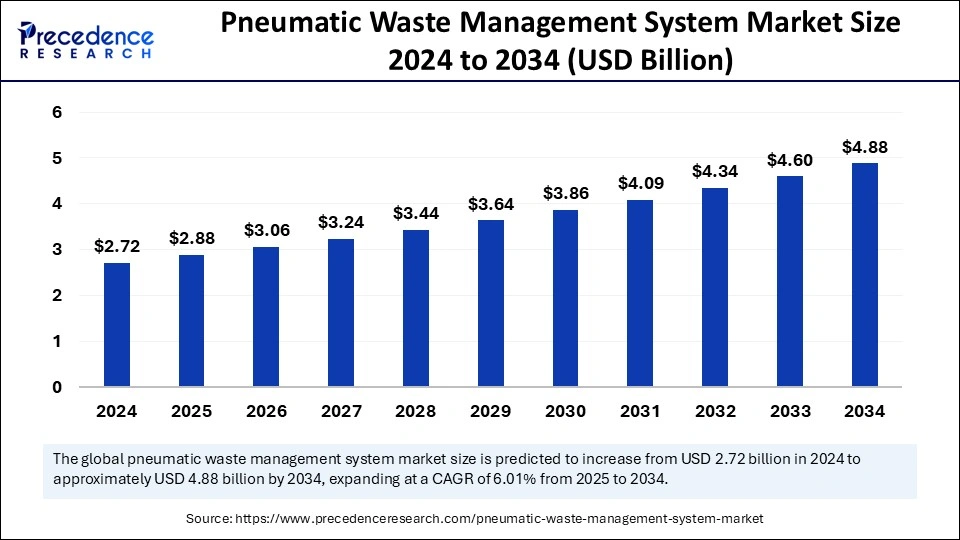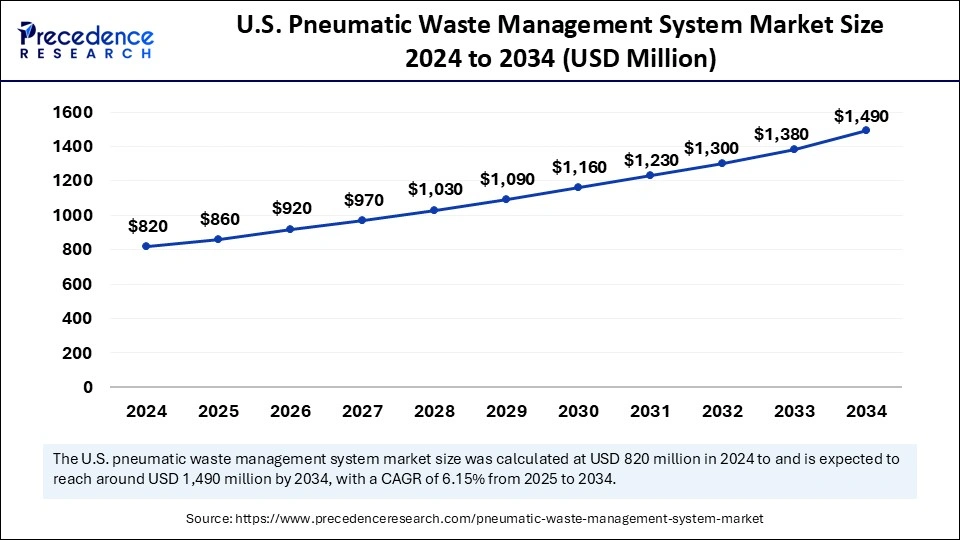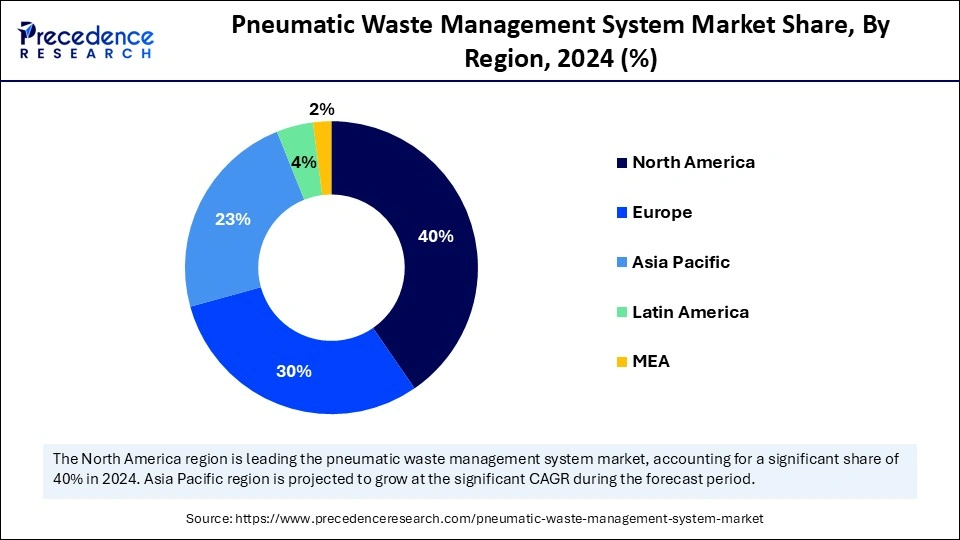The global pneumatic waste management system market size is calculated at USD 2.88 billion in 2025 and is forecasted to reach around USD 4.88 billion by 2034, accelerating at a CAGR of 6.01% from 2025 to 2034. The North America market size surpassed USD 1.09 billion in 2024 and is expanding at a CAGR of 6.14% during the forecast period. The market sizing and forecasts are revenue-based (USD Million/Billion), with 2024 as the base year.
The global pneumatic waste management system market size accounted for USD 2.72 billion in 2024 and is predicted to increase from USD 2.88 billion in 2025 to approximately USD 4.88 billion by 2034, expanding at a CAGR of 6.01% from 2025 to 2034. The rising government regulations on waste management, increasing awareness regarding sustainable waste management practices, rising urbanization, and technological advancements in pneumatic waste management systems are anticipated to drive the growth of the pneumatic waste management system market throughout the forecast period.

In the era of technological innovation, artificial intelligence (AI) emerges as a transformative force and holds great potential to impact the pneumatic waste management system market. From tackling food wastage to managing general waste streams, AI integration is significantly revolutionizing the way to handle waste collection, sorting, disposal process, and recycling waste, leading to more cleaner, efficient, and sustainable urban environments. Using advanced AI technologies such as machine learning, robotics, and computer vision for waste collection and sorting enhances waste management. AI analyzes massive amounts of data, automates repetitive tasks, and improves waste systems efficiency. Therefore, AI integration improves sustainable waste management practices to address the growing global waste challenge to achieve environmental sustainability.
The U.S. pneumatic waste management system market size was exhibited at USD 820 million in 2024 and is projected to be worth around USD 1,490 million by 2034, growing at a CAGR of 6.15% from 2025 to 2034.

North America dominated the pneumatic waste management system market with the largest share in 2024. This is mainly due to stringent regulations regarding the proper disposal of waste. Government initiatives promoting sustainable waste management practices, high demand for smart city solutions, the surge in municipal solid waste generation, and a focus on reducing the environmental footprint and health hazards further bolstered the regional market growth. The U.S. is a major contributor to the market. There is a high adoption of pneumatic waste management systems, particularly in highly dense urban areas. Rapid urbanization in the country resulted in a substantial increase in the volume of waste generation, leading to a high demand for sustainable waste management practices.
Europe is projected to witness rapid growth in the coming years. In European countries, pneumatic waste management systems are widely adopted to transport waste through underground pipes. Due to the stringent waste management policies set by the EU under the Circular Economy Action Plan, there is a high demand for efficient waste management solutions. Several countries, such as the Netherlands, Spain, Germany, and Sweden, have implemented pneumatic waste management systems to cope with escalating waste volumes across urban areas, offering a cleaner and more efficient waste management system. Moreover, the increasing focus on environmental conservation and waste recycling and reduction are expected to boost regional market growth.

Asia Pacific is expected to witness notable growth in the foreseeable future. Rapid urbanization in countries like China, Japan, South Korea, Singapore, and India is a major factor boosting waste volume, leading to increased demand for pneumatic waste management systems. With rapid industrialization, the volume of industrial waste is also increasing. Government’s push toward cleanliness and sanitation and the growing awareness of sustainable waste management practices further support market growth. In addition, rising concerns about waste disposal contribute to the Asia Pacific pneumatic waste management system market growth.
Can Cutting-Edge Technology Unlock New Frontiers in Waste Management Systems?
According to our seasoned specialists, as smart city initiatives gain momentum, the integration of pneumatic waste management systems with other smart technologies, such as IoT-enabled waste bins, is becoming a key trend. These systems provide real-time data to monitor waste collection, reduce overflow risks, and optimize collection schedules, ensuring more sustainable and efficient urban waste management.
Continued advancements in technology, including smart sensors, automated waste sorting, and real-time monitoring systems, are driving the evolution of PWMS. These innovations not only improve operational efficiency but also enhance the system’s ability to handle various types of waste (e.g., organic, recyclable, and non-recyclable) in an automated and optimized manner.
A pneumatic waste management system refers to a system in which waste is widely transported at high speeds through a robust network of underground pipes to a collection station using air pressure. Transporting waste material through pipes eliminates the need for manual waste handling or traditional waste collection trucks, which leads to reducing traffic congestion and lowering carbon emissions in the environment. This method of waste management provides a cleaner, more hygienic, and more efficient way of disposing of waste in dense urban areas.
| Report Coverage | Details |
| Market Size by 2034 | USD 4.88 Billion |
| Market Size in 2025 | USD 2.88 Billion |
| Market Size in 2024 | USD 2.72 Billion |
| Market Growth Rate from 2025 to 2034 | CAGR of 6.01% |
| Dominated Region | North America |
| Fastest Growing Market | Europe |
| Base Year | 2024 |
| Forecast Period | 2025 to 2034 |
| Segments Covered | System Type, Waste Type, End user, and Regions |
| Regions Covered | North America, Europe, Asia-Pacific, Latin America and Middle East & Africa |
Rapid Urbanization and Increasing Population
The rapid urbanization and increasing population are driving the growth of the pneumatic waste management system market. Waste management is a foremost concern for various cities, with rapid urbanization and increasing populations generating large amounts of waste daily. For instance, urban areas with 377 million people generate about 62 million tons of solid waste annually. Only 43 million tons are collected, and the rest either end up in landfills or untreated. Urban areas are increasingly becoming more densely populated, which leads to higher waste generation rates. With the surge in population and rapid urbanization, concerns regarding waste management increase, boosting the demand for pneumatic waste management systems as sustainable waste management practices that facilitate the quick and effective waste disposal process.
According to the report published by the International Trade Administration in April 2023, the Indian Central Pollution Control Board (CPCB) forecast that annual waste generation in India will increase to 165 MT by 2030.
High Initial Investment
Installing pneumatic waste management systems requires substantial investment, which often acts as a barrier for some potential customers and results in limited adoption, especially in middle and low-income countries. In addition, high maintenance and operational costs restrict the expansion of the global pneumatic waste management system market. This waste management system requires regular maintenance and well-developed infrastructure, which can add to the operational costs.
Supportive Government Regulations and Initiatives
Supportive government regulations and initiatives are projected to create lucrative opportunities in the pneumatic waste management system market during the forecast period. Due to the rising environmental concern, several government initiatives, such as India’s Swachh Bharat Mission, are promoting sustainable waste management practices like pneumatic waste management systems. This system uses a network of underground pipes to transport waste through suction technology, which assists in boosting environmental sustainability, enhancing recycling rates, and minimizing the public health risks associated with waste accumulation in urban smart cities. Moreover, rising environmental regulations fuel the growth of the market.
The vacuum system segment accounted for the dominant market share in 2024. This is mainly due to the increase in the adoption of advanced vacuum-based technologies, particularly in developed countries, to transport waste through a network of underground pipes. The vacuum system is mostly preferred in densely populated urban areas due to its space-saving and reduced odor and emissions.
The pressure system segment is expected to witness significant growth during the forecast period. These systems use compressed air for waste conveyance. They are ideal for environments requiring waste removal at a high speed, enabling efficient waste management.
The organic waste segment dominated the pneumatic waste management system market in 2024. This is mainly due to the increased concerns about the disposal of organic waste, such as food and animal manure. Governments of various countries have implemented regulations for proper sorting of various organic waste to make disposal easier, boosting the demand for pneumatic waste management systems.
The plastic waste segment is projected to grow at a notable rate in the coming years. The segment’s growth is attributed to the increasing concerns about plastic pollution. Governments worldwide are implementing stringent regulations to reduce plastic waste. Moreover, the rising consumption of plastic worldwide leads to an increased volume of plastic waste, requiring efficient waste management solutions. Strict regulations on plastic waste disposal further propel the growth of the segment.
The residential segment held the largest share of the pneumatic waste management system market in 2024. This is mainly due to a strong emphasis on waste management. Innovative and sustainable waste management strategies are becoming increasingly popular in residential areas. Pneumatic waste management solutions can transform urban living by reducing manual labor and promoting better hygiene. Several governments are investing significantly in building smart cities. A pneumatic waste management system provides an alternative to conventional waste collection methods in urban residential areas where there is a need to reduce traffic congestion, improve public health, and lower environmental footprint. With supportive government policies and regulations to promote sustainability, the demand for pneumatic waste management systems has increased in the residential sector.
The commercial segment is likely to grow at a significant rate during the projection period. The rising demand for reliable and sustainable waste management systems in commercial settings, such as hotels, resorts, hospitals, office buildings, and shopping malls, is expected to boost segmental growth. With the rapid expansion of commercial buildings, the volume of waste is increasing, boosting the demand for pneumatic waste management systems.

By System Type
By Waste Type
By End-user
By Region
For inquiries regarding discounts, bulk purchases, or customization requests, please contact us at sales@precedenceresearch.com
No cookie-cutter, only authentic analysis – take the 1st step to become a Precedence Research client